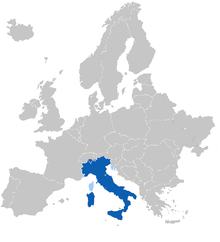Italian language
The Italian language is a Romance language spoken in Italy. Other countries that use Italian as their official language are San Marino, Vatican City and Switzerland. Slovenia, and Croatia also use Italian as an official language, but only in some regions. Italian is spoken by about 70 million people in several countries, including some parts of Monaco, Malta, Albania, Montenegro, Dodecanese (Greece), Eritrea, Libya, Ethiopia, Somalia, Tunisia. The standard version from Tuscany is used for most writing but other dialects are sometimes written.[3]
| Italian | |
|---|---|
| italiano, lingua italiana | |
| Pronunciation | [itaˈljaːno] |
| Native to | Italy, Switzerland, San Marino, Vatican City, Slovenia (Slovenian Istria), Croatia (Istria County), and the Italian diaspora |
| Region | (widely known among older people and in commercial sectors in Somalia, Eritrea, and Libya; used in the Federal Government of Somalia) |
Native speakers | 59 million Italian proper, native and native bilingual (2007)[1] 85 million all varieties[2] |
| Latin (Italian alphabet) Italian Braille | |
| Official status | |
Official language in | |
Recognised minority language in | |
| Regulated by | not officially by Accademia della Crusca |
| Language codes | |
| ISO 639-1 | it |
| ISO 639-2 | ita |
| ISO 639-3 | ita |
| Linguasphere | 51-AAA-q |
 Where Italian is spoken in Europe | |
Spoken
changeIt is mostly derived from Latin, with some words from Greek, Etruscan and elsewhere. It is called an inflected language - that means that the meaning of words can be changed by changing their endings. Italian nouns are either masculine or feminine in gender (these usually have little to do with natural genders).
Most singular masculine nouns end in -o, and most plural masculine nouns end in -i.
Most singular feminine nouns end in -a, and most plural feminine nouns end in -e.
So:
- gatto = male cat
- gatta = female cat
- gatti = male cats
- gatte = female cats
The ending of verbs are quite complicated because of conjugation. The endings depend upon the tense of the verb (past, present, future and so on) and on the person of the verb (I, you, they etc.). Because Italian grammar uses endings for these inflections, the personal pronoun is not always needed (in the following example it is in parenthesis).[4]
So:
- (io) parlo = I speak
- (noi) parliamo = we speak
- (lui) parlava = he was speaking
- (loro) parlarono = they spoke
- (io) parlerò = I will speak
- parliamo! = let's speak!
There are very many of these endings to learn - it is one of the more difficult parts of the Italian Grammar. But pronunciation is simple - there are just a few rules to learn, and hardly any difficult sounds.
Many Italian words for food have entered the English language, such as: pizza, spaghetti and ravioli. Many technical words in music are Italian, such as forte and allegro. Many musical instrument names are also Italian, such as cello and tuba. Mafia and vendetta come from the darker side of Italian culture.
Pidgin versions of the Italian language were developed in the colonies of Italy:[5] the most important were in Eritrea, Somalia and Libya.[6]
Further reading
change- Berloco, Fabrizio (2018). The Big Book of Italian Verbs: 900 Fully Conjugated Verbs in All Tenses. With IPA Transcription, 2nd Edition. Lengu. ISBN 9788894034813.
- Palermo, Massimo (2015). Linguistica italiana. Il Mulino. ISBN 9788815258847.
- Simone, Raffaele (2010). Enciclopedia dell'italiano. Treccani.
References
change- ↑ Nationalencyklopedin "Världens 100 största språk 2007" The World's 100 Largest Languages in 2007
- ↑ Eurobarometer – Europeans and their languagesPDF (485 KB), February 2006
- ↑ Simone 2010
- ↑ Berloco 2018
- ↑ "Pidgin italiani" (PDF). Archived from the original (PDF) on 2011-06-26. Retrieved 2022-03-16.
- ↑ Italian language pidgins in Italy's colonies
Other websites
change- Italian grammar and interactive course
- Italian proverbs
- Italian Learning Tips Archived 2021-01-26 at the Wayback Machine
- Italian Grammar Primer Archived 2008-04-16 at the Wayback Machine
- Italian Online Dictionaries and Glossaries Archived 2007-12-26 at the Wayback Machine
- A dictionary of Italian orthography and pronunciation
- English-Italian Dictionary and English-Italian Dictionary on http://www.wordreference.com/